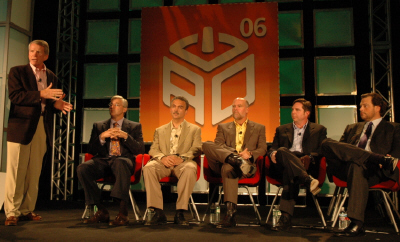AlwaysOn: SaaS love fest

Ray Lane, of Kleiner Perkins Caufield & Byers, led the panel of software executives and competitors (you can see some wincing and uncomfortable body language among some of the participants if you are watching the Always On Stanford Summit Webcast), discussing whether the software as a service model has finally arrived. Given the bias of the panel members--Marc Benioff, CEO, Salesforce.com; Brett Caine, President, Citrix Online Division, Citrix Systems; Greg Gianforte, CEO and Founder, RightNow Technologies; George Kadifa, General Manager, On Demand Group, IBM; and Zach Nelson, CEO, NetSuite--the verdict was a predictable resounding yes.
Phil Wainewright is also blogging about the panel.

Ray Lane, Zach Nelson, George Kadifa, Greg Gianforte, Brett Caine, Marc Benioff
It's a simpler, better business model and customers are responding in droves, said Caine. The Internet is the great equalizer, and we have to think in new paradigms, he added. Benioff stated gets down to making customers more successful at lower cost. Kadifa noted that software as a service or on demand extends to the process layer, citing a Paychex, a major, but unheralded demand company that processes 98 percent of U.S. company payrolls.
Gianforte said that software as a service CRM is only about 10 percent of market at this point--$500 million out of a $5.5 billion market. It's still the early days, but the trending is clear.
Some of the challenges are security, moving data outside the firewall and integration with other applications, Lane said, but the panelist mostly dismissed those as major barriers. Benioff cited several major financial industry customers as evidence.
Gianforte said that Sarbannes-Oxley compliance is a challenge for larger companies, which dictated an approach for RightNow in which customers are segmented, rather than in a multi-tenant, shared hosted environment. Nelson brought up integration as an issue, especially for transactions. "There are no mashups for that in the enterprise, and that's why suites win," he said.
Kadifa said that end users will always do front end integration, but on the backend some integration is needed on the transaction layer. "Both of them can coexist. I don't think that's a debate. There will be specialization, with focused business applications. It's not suites versus point solutions.
Benioff said that "mashups are the future," pointing to the composite applications in Salesforce.com's AppExchange. Lane agreed: "It's the early days but even in enterprise we can see end users finding services and figuring out how to use them together. The enterprise will mirror the consumer market." Basically, enterprise can defeat the viral adoption of Web-based applications. "Somewhere along the way enterprise software forgot about the end users," he added.